Ready to dive into a bird-watching adventure in Canada? As you venture into the heart of the forests or explore the shores, these winged wonders will definitely captivate your heart with their speed and agility. In this article, we will list the top 10 fastest birds in Canada. We’ll also discover the prime locations where you can observe them in their natural habitat. This guide will be your handy companion in spotting these fascinating birds in Canada. So, what are you waiting for? Let the bird-watching adventure begin!
10. Gyrfalcon (Falco rusticolus) – 68 mph
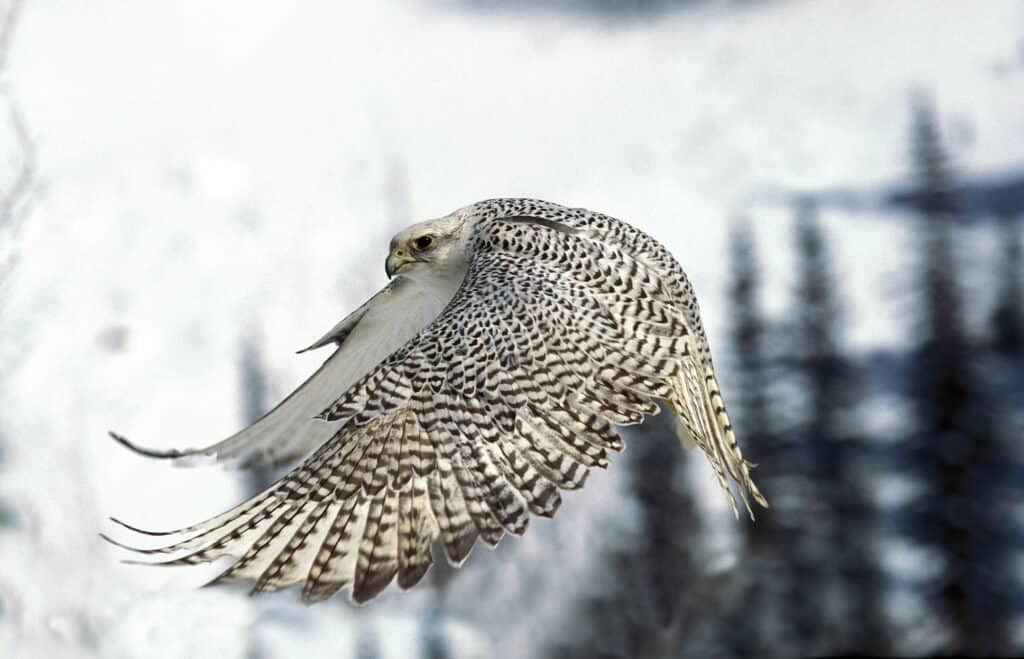
One of the fastest birds in Canada is the gyrfalcon.
©iStock.com/slowmotiongli
Securing the 10th spot on the list is the gyrfalcon, renowned as the largest true falcon in the world, boasting a top flying speed of 68 mph!
Gyrfalcons are sizable birds, displaying three distinctive feather color patterns: gray, black, and white. The bird’s dark eyes; distinctively notched beak, also known as a tomial tooth; and sharply pointed wings — with its size and color — make its identification particularly easy.
The males of this species typically measure between 19 and 24 inches in length. On the other hand, females have a bulkier build, extending from 20 to over 25 and a half inches. Their diet primarily consists of birds, though they occasionally prey on some mammals, focusing mainly on bird species that range from medium to large in size.
There’s been a gradual rise in the number of gyrfalcons wintering since 1970. Their breeding territories in remote northern areas have shielded them from the adverse effects of pesticides, a threat that heavily affected the peregrine falcons.
Where Can You Find the Gyrfalcon?
Thriving in the severe climates that our planet offers, the gyrfalcon is a native of mountainous terrains and the elevated arctic tundras, predominantly residing in regions surrounding the North Pole. The nesting grounds are also mainly located in the arctic and subarctic areas of Canada.
In their search for food during the colder months, gyrfalcons migrate southward from their arctic homes. The distance of their southern journey can vary greatly each year, making their appearance somewhat unpredictable!
9. Common Eider (Somateria mollissima) – 70 mph
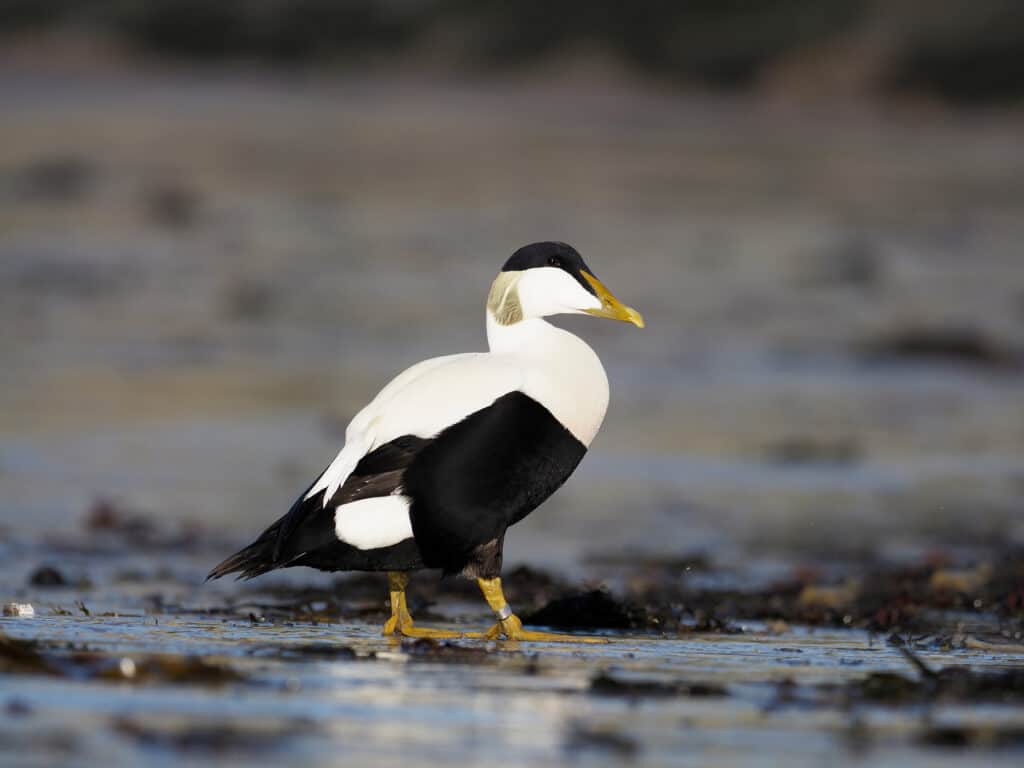
The common eider can reach speeds of up to 70 miles per hour.
©Erni/Shutterstock.com
Coming in at number 9 is the common eider. This bird is one of the fastest birds in Canada, clocking in at an impressive 70 mph.
Male birds in their breeding phase have a predominantly white upper body and black lower body, a black head covering, a light green patch at the back of their neck, and a bill ranging from green to a yellow-orange color. The younger and non-breeding males feature a chocolate-brown plumage with sporadic white markings on their chest and back, while females showcase a warm brown color with a pattern of dense black lines and a completely black bill.
This bird is the largest duck in Canada, with an average length ranging from 20 to 28 inches. Generally, the males are slightly bigger than the females. The adult common eiders feed on sea creatures such as mollusks and crustaceans. Specifically, they feed on spider crabs, sea urchins, marine worms, and fish eggs.
Where Can You Find the Common Eider?
Different populations of the species reside in specific areas. The northern race, scientifically named Somateria mollissima borealis, nests in the eastern Canadian Arctic, ranging from northern Labrador to Ellesmere Island.
The Hudson Bay population, known as Somateria mollissima sedentaria, stays within the Hudson Bay vicinity throughout the year. Meanwhile, the Pacific group, identified as Somateria mollissima v-nigra, establishes its breeding grounds from the MacKenzie District’s Coronation Gulf to the southern areas of the Alaskan peninsula.
8. Canvasback (Aythya valisineria) – 70 mph
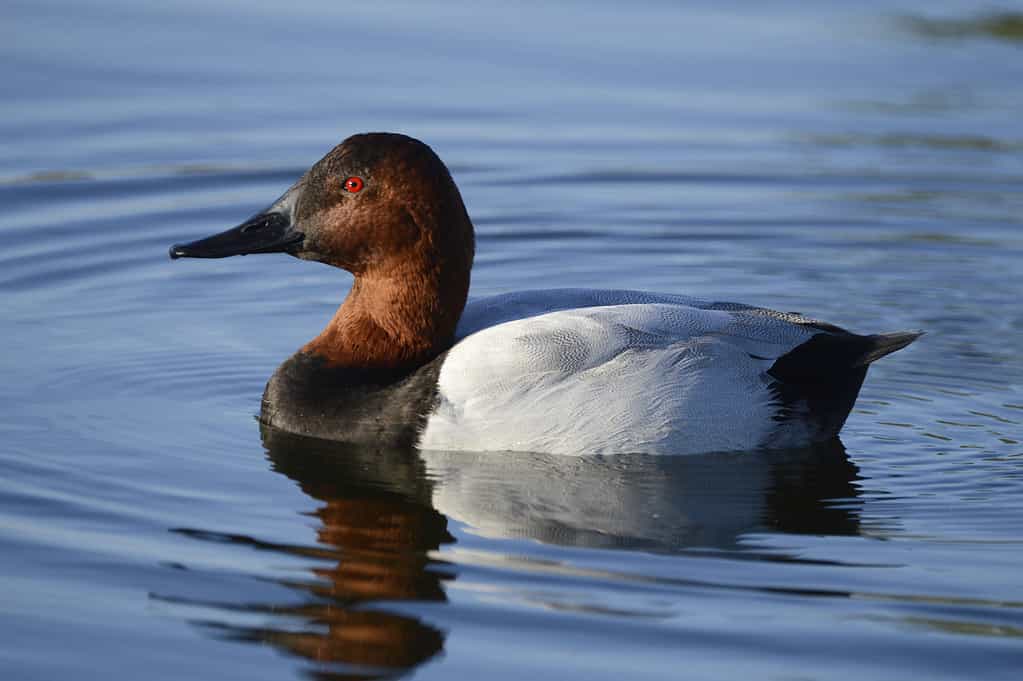
The largest diving duck in North America, the canvasback can reach speeds of up to 70 mph.
©Wirestock/iStock via Getty Images
Canvasbacks usually fly at speeds of about 50 mph, although they can accelerate up to 70 mph when necessary.
Canvasbacks carry their elongated, sloping foreheads proudly. The males are easily recognizable with their red-brown head and neck, contrasted with a bright, almost white body framed with black elements. Although females have a light brown appearance, their unique head shape makes them relatively easy to identify.
Holding the record as the biggest diving duck found in North America, canvasbacks measure about 20 to 21 inches in length. They also flaunt a wingspan between 31 and 35 inches. Their diet is primarily composed of aquatic vegetation, including pondweeds, wild celery, and grasses, consuming the leaves, roots, and seeds. They also feed on mollusks, insects, and a few small fish.
Where Can You Find the Canvasback?
This bird species begins nesting quite late in the season, typically around the end of May, in regions like Manitoba, Saskatchewan, and Alberta. They usually construct their nests in the proximity of open water, favoring the shallow parts of extensive marshes or swampy regions surrounded by plants.
These birds have their breeding grounds spread from Alaska through the Yukon to the western boundaries of the Northwest Territories, extending to the parklands and mixed prairies of central North America.
7. Canada Goose (Branta canadensis) – 70 mph
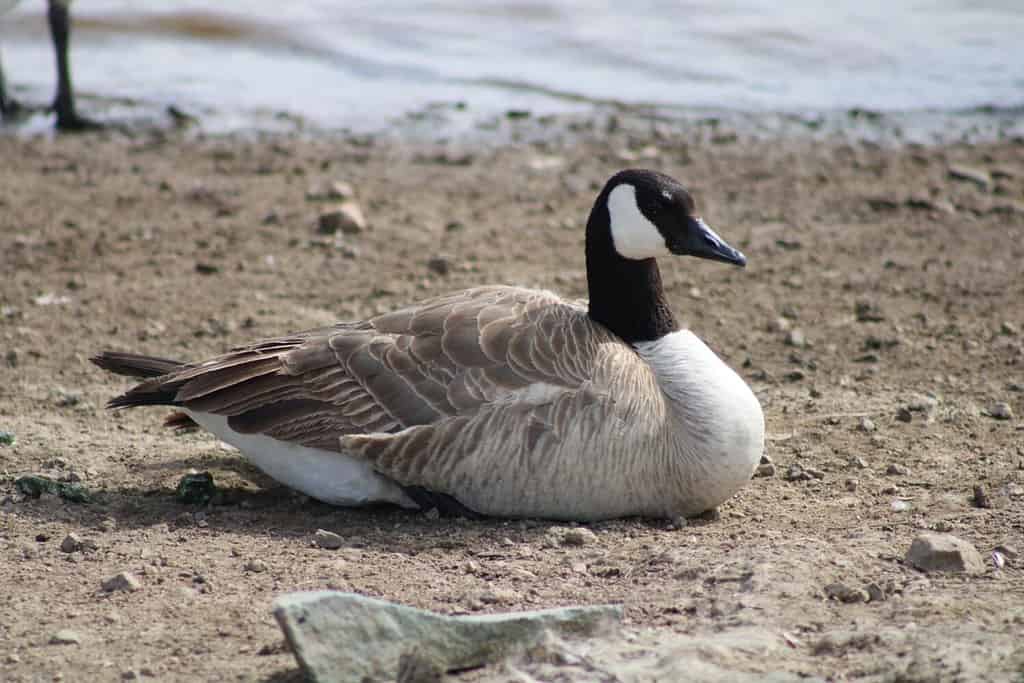
Canada geese usually maintain speeds of 40 mph but can reach up to 70 mph with the help of a tailwind.
©Charlotte Evelyn/Shutterstock.com
Taking the seventh spot, the Canada goose usually maintains a speed of around 40 miles per hour when migrating, but this can surge to 70 miles per hour if they find themselves aided by a tailwind.
The Canada goose is a prominent and easily recognized bird throughout North America, characterized by its black head and neck, contrasted with a notable white patch under the chin. Their body is a brownish-gray color on the upper parts, complemented by a slightly lighter brown on the breast and sides.
These geese vary in length from 30 to 43 inches and have a wingspan that stretches between 50 and 75 inches. Their diet primarily consists of stems and shoots from grasses and aquatic plants. While they mostly feed on vegetation, they sometimes supplement their diet with insects, mollusks, crustaceans, and small fish.
Where Can You Find the Canada Goose?
Canada geese are a common sight in every Canadian province at different times throughout the year. Depending on the region, their habitats are versatile, including lakes, ponds, marshes, and fields. They always establish their nests close to water sources and choose wintering locations where food sources are easily accessible from water bodies.
Being one of the most well-known birds in Canada, spotting a Canada goose during the summer is easy. As the seasons progress, they can be found swimming in open waters, resting near the shorelines, or foraging on grassy lands.
6. Mallard (Anas platyrhynchos) – 70 mph

Mallards are the most common dabbling duck species in Canada.
©mirceax/iStock via Getty Images
Coming in at number six on our list of fastest birds in Canada, mallards have been known to reach speeds up to 70 mph while flying, although their usual cruising speed is around 30 mph.
The mallard is a big and somewhat bulky duck. Its structure is elongated with a similarly long, broad beak. The males are recognizable by their dark green heads and yellow beaks, along with a purple-brown chest and gray body. On the other hand, the females exhibit a predominantly brown hue complemented by an orange beak.
In terms of size, the mallard outweighs many other types of dabbling ducks, measuring between 20 and 26 inches in length. Their wingspan ranges between 32 and 39 inches.
A significant portion of their diet consists of plant-based materials such as seeds, stems, and roots from a wide array of plants. However, they also consume insects, mollusks, and small aquatic animals like frogs.
Where Can You Find the Mallard?
In Canada, mallards are the most common and widespread dabbling duck species, predominantly found in the Prairie provinces. Over the years, they have expanded their habitat eastward, now having a substantial presence in the Maritimes as well.
Mallards that are native to Canada and Alaska undertake migratory journeys during the fall season, heading towards warmer locales in the southern parts of the United States and northern areas of Mexico, following established migration routes known as flyways.
5. Red-Breasted Merganser (Mergus serrator) – 100 mph
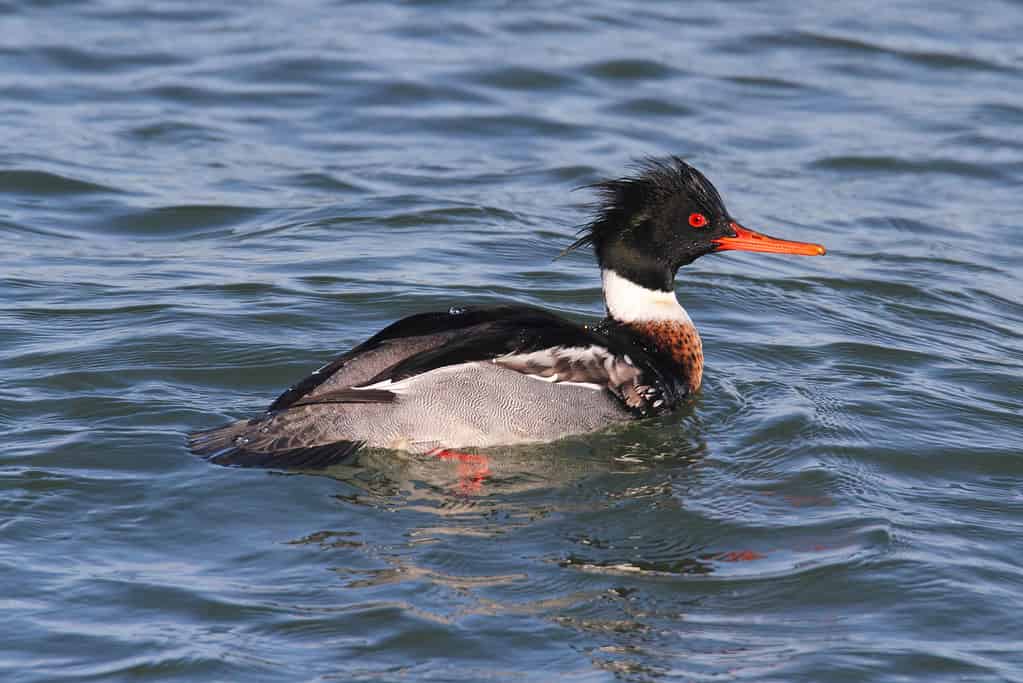
Notably, red-breasted merganser has managed to reach speeds of up to 100 mph!
©SteveByland/iStock via Getty Images
The record for the fastest duck is held by the red-breasted merganser, which managed to reach a remarkable airspeed of 100 mph!
The red-breasted merganser is recognized for its messy crest at the back of its head and its elongated, reddish-orange beak that has tooth-like edges. On its wings, you can notice distinct white areas known as specula. As with many other birds, the males and females exhibit different patterns and colors in their appearance.
An adult red-breasted merganser measures between 20 and 25 inches in length and has a wingspan that ranges from 26 to 29 inches. Their diet mainly consists of small fish, although they occasionally consume crustaceans, insects, and tadpoles as well. During the summertime, their feeding grounds are shallow waters rich in submerged plants and abundant fish populations.
Where Can You Find the Red-Breasted Merganser?
These birds are found across vast areas of Canada, even establishing breeding grounds as far north as 75 degrees latitude. Despite their wide distribution, they are considered to be among the less common sea ducks found in Canada, though the overall population seems to be on an upward trend.
Red-breasted mergansers have breeding areas spread across the boreal forests and tundra regions throughout the Northern Hemisphere. Their breeding grounds do not extend to the furthest northern islands in the Canadian Arctic. The southernmost boundary of their habitat stretches from the southern parts of Yukon, passing through the Great Lakes area and extending up to the Maritimes.
4. Bald Eagle (Haliaeetus leucocephalus) – 100 mph
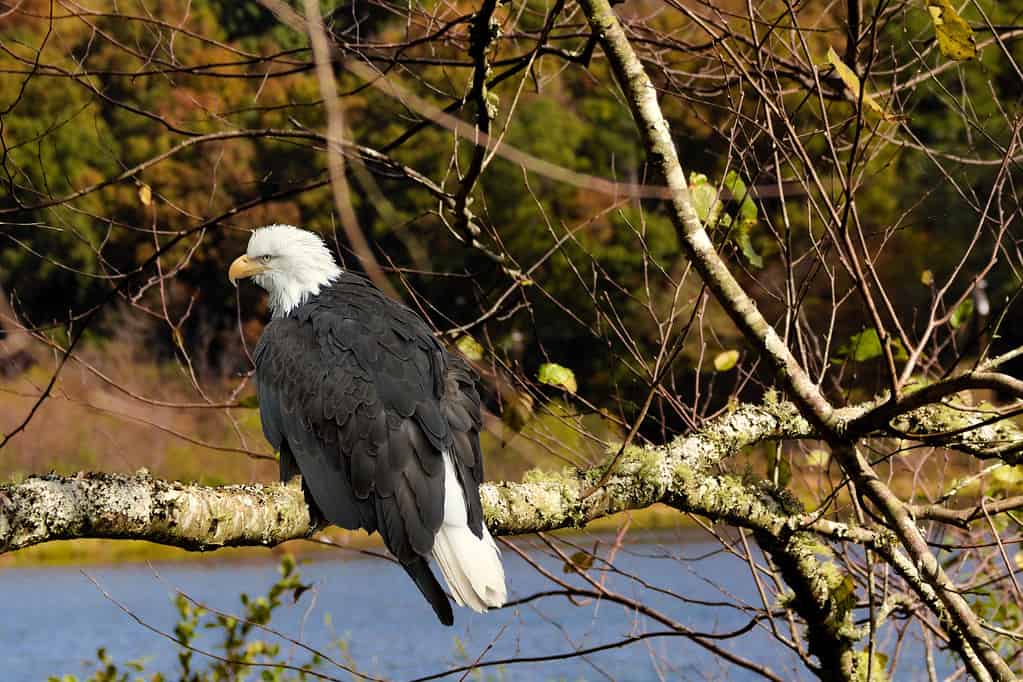
Reaching up to 100 mph in speed, the bald eagle is one of the fastest birds in Canada.
©Victor Ward/iStock via Getty Images
The bald eagle can achieve speeds of up to 100 mph, especially when it is swooping down to catch its prey.
Fully grown bald eagles are mostly brown, but they have a striking white head, neck, and tail. Their eyes are a light yellow color, which matches the color of their beaks and feet.
The length of a bald eagle can vary between 28 and 40 inches. Notably, female eagles are about 25% larger than their male counterparts. The average wingspan of these birds is about 6 to 7.5 feet.
When it comes to diet, these eagles clearly prefer fish, which is why they are often found where fish are plentiful. They also consume sea birds and ducks or seek out small land mammals such as rabbits and squirrels in grasslands and marshy areas.
Where Can You Spot the Bald Eagle?
A significant portion of Canada’s bald eagle community resides along the coast of British Columbia. You can also find them in the boreal forests spread across the country, including the regions surrounding the Atlantic. It’s essential for them to have access to large trees for building nests.
In Brackendale, a little settlement situated to the north of Vancouver in British Columbia, a remarkable gathering of bald eagles occurs between November and March. Thousands flock there to feed on the plentiful salmon in the nearby Cheakamus and Squamish rivers.
3. Red-Tailed Hawk (Buteo jamaicensis) – 120 mph

Red-tailed hawks can reach up to 120 mph!
©David Brace/Shutterstock.com
At the third position, we find an extraordinary bird. When a red-tailed hawk dives down to snatch its meal, it can hit impressive speeds of up to 120 miles per hour!
A majority of red-tailed hawks have a rich brown color on their upper parts and a lighter color below, featuring a streaked abdomen. On the underside of their wings, there is a dark band connecting the shoulder and wrist area. While the tail generally sports a cinnamon-red top and paler bottom, younger hawks have a brown, striped tail.
These hawks measure between 18 and 25 inches and flaunt a wingspan of about four feet. They mostly hunt rodents, reptiles, rabbits, squirrels, and even other birds. To eat, they use their sharp, hooked beaks to shred their catch into manageable portions. Interestingly, red-tailed hawks are known to snatch meals from other predatory birds, including eagles and owls.
These hawks are among the most frequently spotted in Canada. According to data from the Breeding Bird Survey and the Christmas Bird Count, their numbers in Canada have seen an upsurge since 1970.
Where Can You Spot the Red-Tailed Hawk?
During the summer, red-tailed hawks breed across various parts of Canada. Pairs generally choose the subarctic areas for nesting and habitually return each year as the harsh winter weather subsides.
You can find their breeding habitats stretching from the northwest’s Yukon Territory, moving southwards to British Columbia, and extending east through regions like Saskatchewan, Ontario, and southern Quebec. Their territory also covers the southern areas of Labrador and reaches as far as southern Nova Scotia in the east.
2. Golden Eagle (Aquila chrysaetos) – 200 mph
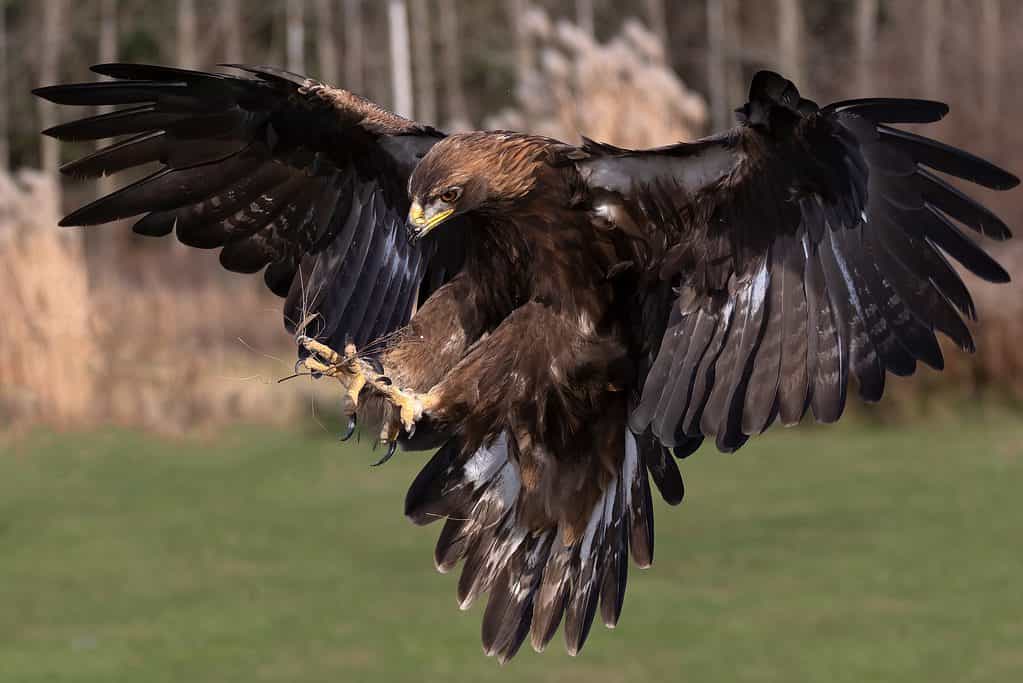
The second fastest bird in Canada is the golden eagle.
©Touched by light images/Shutterstock.com
Securing the second spot are the golden eagles, who are known for their remarkable speed and agility despite their considerable size. They can fly down from significant heights, reaching speeds of 200 miles per hour!
The golden eagle boasts dark brown feathers with white sections at the tail base and golden-colored feathers gracing the back of its head. Their beak and claws are of a dark hue. Younger birds can be identified by a wide white band on their tail with a dark border, coupled with substantial white areas on the bottom of their wings.
These birds have a robust build, ranging from 27 to 33 inches in length, and spread their wings to an expansive 6 feet 6 inches. They primarily feast on mammals and birds, both living and dead. Their typical prey includes medium-sized mammals and birds like rabbits and hares. Coastal birds have been known to prey on gulls and other seabirds.
Where Can You Spot the Golden Eagle?
In Canada, you can mostly find golden eagles in the mountainous and prairie regions of the west, although they are also commonly seen in Labrador and the Ungava peninsula in Quebec. During migration periods, they might appear anywhere, but they are most commonly spotted migrating westward along the edges of Lake Ontario and Erie in November.
While migration is not common to all golden eagles, the majority in the northern and eastern parts of Canada tend to move south when fall arrives.
1. Peregrine Falcon (Falco peregrinus) – 242 mph

Of course, the fastest bird in the world is also the fastest bird in Canada: the peregrine falcon!
©Harry Collins Photography/Shutterstock.com
Claiming the top spot, with a lightning speed of over 240 mph, the peregrine falcon is the fastest bird not only in Canada but in the world!
This bird sports long, broad, and pointed wings coupled with a rather short tail. Its upper body showcases a blue-gray hue, accompanied by a dark area on the head’s top and a notable black “mustache” feature contrasting against its white face. The chest region displays fine stripes.
Standing at around 1.5 feet, the peregrine falcon extends its wings to a breadth of 3.5 feet. These falcons inhabit all continents, with the exception of Antarctica.
They have a diverse diet, consuming birds of varying sizes, from large ones like sandhill cranes to tiny hummingbirds. Their common prey comprises shorebirds, ducks, grebes, gulls, pigeons, and songbirds. Moreover, they consume bats and occasionally snatch prey such as fish and rodents from other birds of prey.
Where Can You Spot the Peregrine Falcon?
In the northern parts of Canada, peregrine falcons usually establish their nests on cliff edges near extensive river networks. In recent years, urban areas in the southern parts of Canada have witnessed an increase in the nesting of these falcons, utilizing structures like buildings and bridges for nesting. Now, they can be seen nesting in Toronto and various other cities in southern Ontario.
Regardless of their global location, peregrine falcons initiate their breeding phase during the spring season. This is the ideal time to spend more hours observing them in the field, as the falcon pairs are expected to showcase excellent flying, mating, and displaying behaviors, especially before egg-laying commences in early spring.
Summary of the Top 10 Fastest Birds in Canada
| Number | Bird | Scientific Name | Speed |
|---|---|---|---|
| 1. | Peregrine Falcon | Falco peregrinus | 242 mph |
| 2. | Golden Eagle | Aquila chrysaetos | 200 mph |
| 3. | Red-Tailed Hawk | Buteo jamaicensis | 120 mph |
| 4. | Bald Eagle | Haliaeetus leucocephalus | 100 mph |
| 5. | Red-Breasted Merganser | Mergus serrator | 100 mph |
| 6. | Mallard | Anas platyrhynchos | 70 mph |
| 7. | Canada Goose | Branta canadensis | 70 mph |
| 8. | Canvasback | Aythya valisineria | 70 mph |
| 9. | Common Eider | Somateria mollissima | 70 mph |
| 10. | Gyrfalcon | Falco rusticolus | 68 mph |
The photo featured at the top of this post is © Harry Collins Photography/Shutterstock.com
Thank you for reading! Have some feedback for us? Contact the AZ Animals editorial team.






